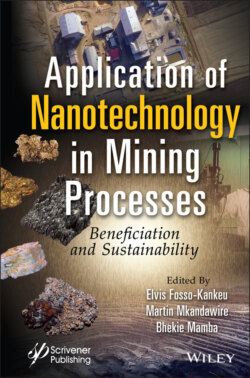Читать книгу Application of Nanotechnology in Mining Processes - Группа авторов - Страница 10
Оглавление
Preface
Nanotechnology, initially expected to revolutionize processes in industries, has affected fields in engineering in different ways. For example, the application of nanotechnology in mining processes such as minerals processing and hydrometallurgy has received limited attention so far.
Mining plays a vital role in the economic development of many countries around the world; it is, therefore, understandable that the technologies applied in mining must ensure cost-effective recovery of values from the ore and minimize the impact of processes on the environment. After extraction of ore minerals, they must be separated from the gangue to be processed for metal extraction via a process such as hydrometallurgy which is less energy demanding and has a limited impact on the environment. Although hydrometallurgy has less impact on the environment than pyrometallurgy, the former still contributes to the discharge of solid wastes containing residual sulphide minerals that can be oxidized to form acid mine drainage in the environment. However, little research has been reported on the application of nanotechnology in three mining processes, vis mineral processing (concentration through flotation), hydrometallurgy (concentration or purification of metals loaded solution) and management of mining liquid wastes to minimize environmental impact.
Ore minerals are generally dispersed in a large volume of gangue minerals, requiring therefore that the rock is crushed to small particles for the beneficiation of valuable minerals through froth flotation, which consists of the floatation of crushed particles in an aqueous solution containing “collector chemical” that can attach to the valuable particles allowing them to remain at the top of bubbling solution and making easier to skim them off. In conventional froth flotation, air bubbles are relatively large and less stable; recent findings have shown that the application of nanoflotation can considerably improve the separation of valuable minerals from gangue minerals through the use of hydrophobic nanoparticles or the formation of nanobubbles using special dispersing pumps.
The concentration and purification processes in hydrometallurgy often require selective extraction from solution. However, conventional techniques such as ion exchange and solvent extraction still have low efficiencies. For example, solvent extraction often results in an unpure solution due to poor coalescence of the organic solvent, which contaminates the aqueous solution, also resulting in the loss of expensive reagents. In contrast, conventional semipermeable membranes made of aggregates of polymers and ion exchangers tend to be non-selective because the absence of atomistic control limits sufficient exposure of sidechains to the solution. Recently, nanoscale supramolecular hosts exhibiting selective, high-capacity and recyclable adsorption potential have been developed and applied to extract metals from leachates or pregnant solutions with great success.
One major impact of mining activities on the environment is the formation of acid mine drainage, a very acidic solution rich in metals that can negatively affect aquatic life. One of the approaches to remediate AMD pollution often consists of removing metals using nano-adsorbents with a very large surface area and, therefore, high adsorption capacity. These nano-adsorbents are also used to extract and separate rare earth elements (REE) from mine effluents. In addition, a new approach focusing on the circular economy promotes the valorization of mine wastes such as AMD, resulting in the production of nano-based materials with economic values.
This book presents nine specialized chapters that focus on applying nanoflotation to improve mineral processing, effective extraction of metals from leachates or pregnant solutions using nanoscale supramolecular hosts, and development of nano-adsorbents or nano-based strategies for the remediation or valorization of AMD.
The editors and the publisher are grateful to the reviewers who have contributed to improving the quality of the book through their constructive comments. The editors also thank the publisher for including this book in their portfolio.
This book will be of interest to researchers from the fields of Environment, Chemistry, Engineering, Mineral processing, Hydrometallurgy and Geochemistry, engineers and environmentalists from the mining industry, as well as the environmental policies makers mostly in the public sector, to name a few. Furthermore, it is our wish that this book assists the readers in improving their experimental and operational processes by implementing the ideas disseminated in the various chapters of this book.
Elvis Fosso-KankeuMartin Mkandawire Bhekie B. Mamba January 2022
